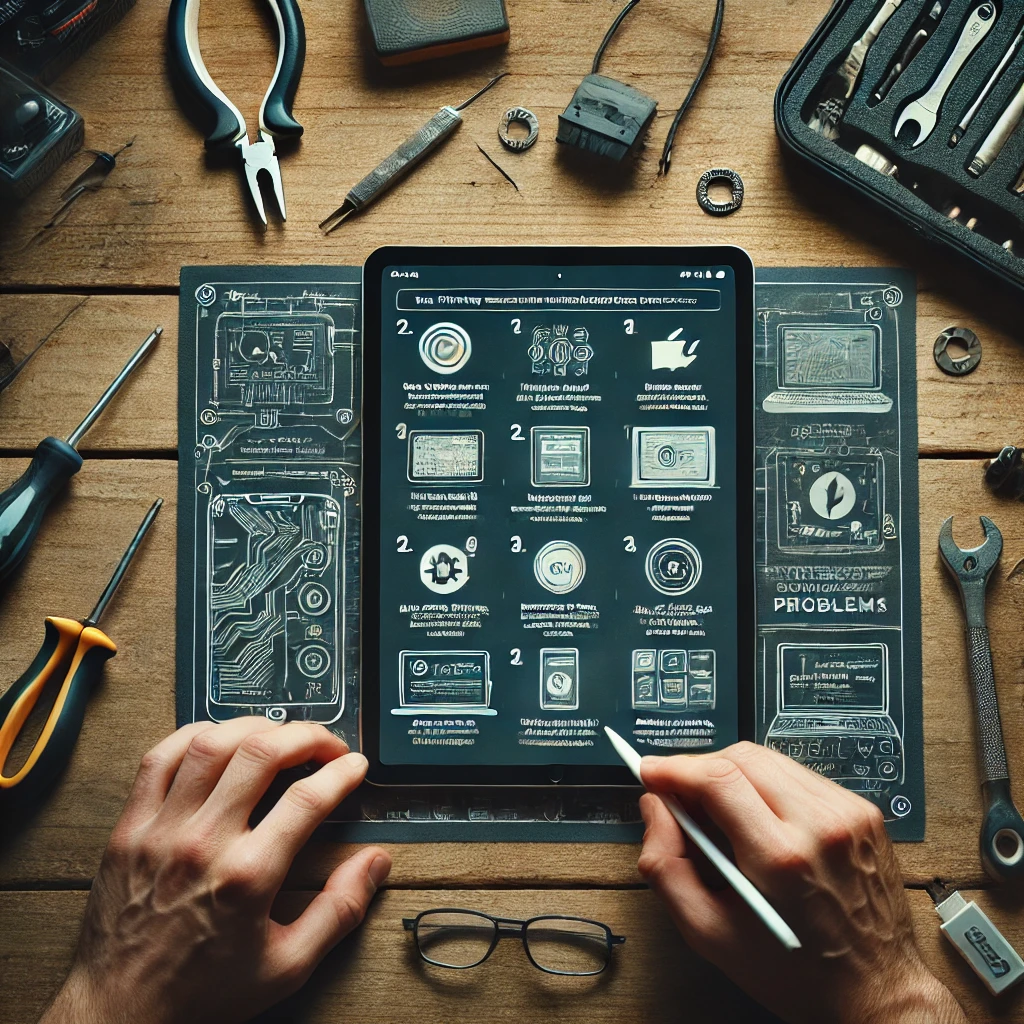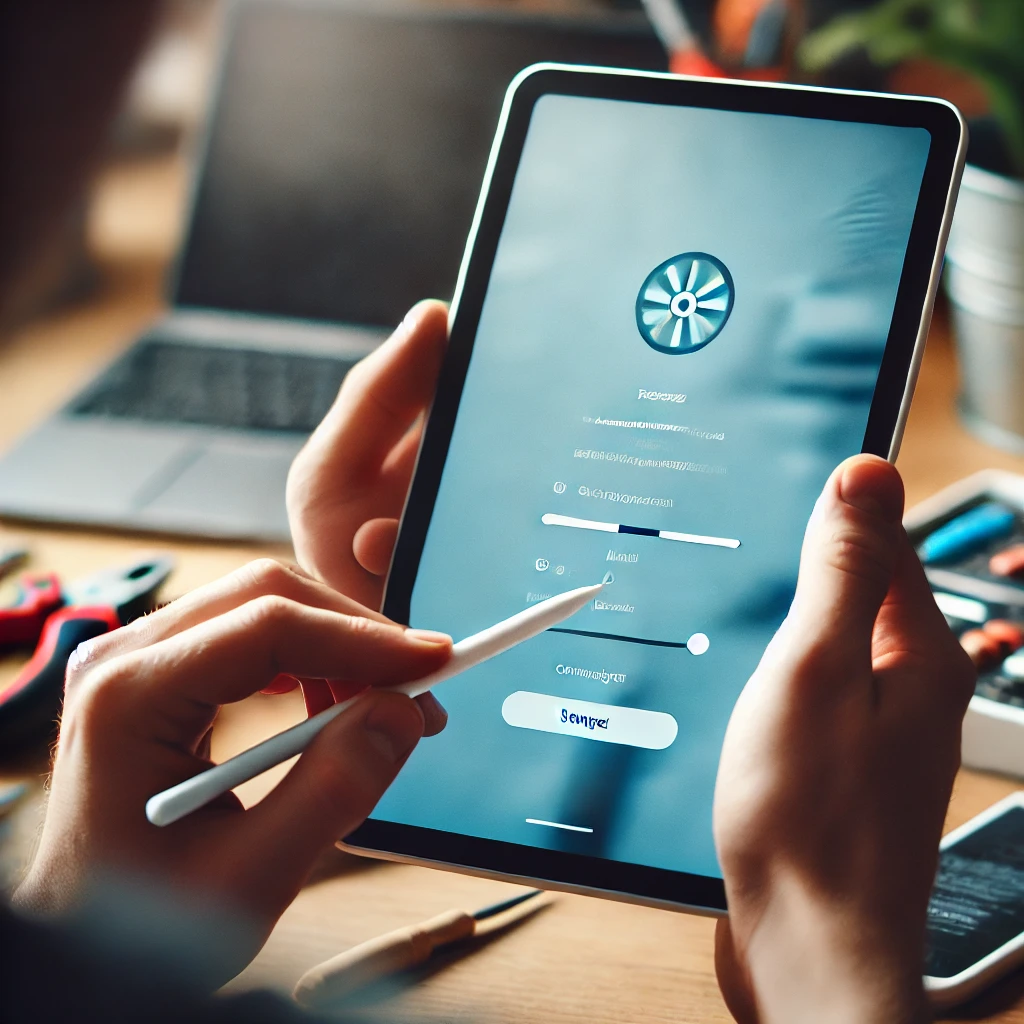Table Of Contents
Essential Guide to Troubleshooting Common Issues with Tablets
Key Takeaways
- Recognizing frequent tablet difficulties and their solutions
- Determining steps for effective problem-solving
- Addressing connection-related complications
- Managing power and charging obstacles
- Resolving display-related issues
- Fixing application-related concerns
Troubleshooting Common Issues With Tablets | Understanding Common Tablet Problems
Troubleshooting Common Issues with Tablets can often feel overwhelming, especially with the diverse range of devices available, such as Samsung tablets. Users frequently encounter slow performance, app crashes, and connectivity issues, which can hinder their experience. Effective troubleshooting involves identifying the root causes and employing strategies like bug fixes, updates, and regular scans for malware. By understanding how to troubleshoot common tablet problems, users can enhance the functionality of their devices significantly, ensuring smoother operation of apps and overall performance. Whether dealing with a tablet press issue or trying to optimize a Samsung tablet, the right approaches can lead to a more satisfying user experience.
- Regularly update the tablet’s software to benefit from performance improvements and bug fixes.
- Clear cache and data of problematic apps to resolve crashes and slowdowns.
- Check Wi-Fi or cellular connectivity settings to troubleshoot internet issues.
- Restart the tablet periodically to refresh the system and improve performance.
- Ensure sufficient storage space is available by removing unnecessary files and apps.
- Run antivirus or malware scans to protect against malicious software affecting functionality.
- Reset the tablet to factory settings as a last resort if persistent issues remain unresolved.
Troubleshooting Common Issues with Tablets | Slow Performance
Slow performance on tablets can stem from various factors, making troubleshooting common issues with tablets crucial. Android apps and phones, particularly popular models like Samsung phones, may experience delays due to background processes or outdated software. Regular software updates are essential for optimizing device performance. Checking for bugs within specific applications can also help, as sometimes an app may require uninstalling and reinstalling to function effectively.
Heavy usage of the internet can strain the tablet’s resources, contributing to sluggish response times. Battery issues can also impact performance; a failing battery may not provide adequate power for smooth operation. Ensuring the device is charged appropriately and that all unnecessary apps are closed can significantly enhance speed. Recognizing these factors is key to troubleshooting common issues with tablets effectively and achieving a better user experience.
Frequent Crashes
Frequent crashes can often be attributed to software issues or hardware malfunctions. Users of Samsung tablets may experience this common tablet problem due to outdated software or applications that are not optimized for the device. Troubleshooting common issues with tablets may involve booting the device into safe mode, allowing you to isolate problematic apps. If the crashes persist, it may indicate a deeper hardware issue requiring further investigation.
Another aspect of troubleshooting common issues with tablets involves the touchscreen’s responsiveness during crashes. A malfunctioning keyboard or touch interface can contribute to the instability of applications, resulting in frustrations for users. Addressing these common tablet issues may include checking for software updates, ensuring app compatibility, or even performing a factory reset if necessary to restore the tablet to optimal performance.
Identifying Troubleshooting Steps
Recognizing the right troubleshooting steps is essential for addressing many tablet issues effectively. Common tablet defects like slow performance, frequent crashes, and connectivity problems can often be resolved through basic troubleshooting techniques. Restarting the device is a fundamental step that can clear temporary glitches. Updating software also plays a vital role in tackling tablet-related problems, ensuring that all features run smoothly. Understanding these essential troubleshooting methods is crucial for resolving both tablet-related issues and non-tablet issues that may arise, particularly with popular brands like Samsung and Android tablets. By following these initial steps, users can significantly mitigate tablet breaks and enhance overall performance.
| Issue | Troubleshooting Step | Description |
|---|---|---|
| Slow Performance | Restart the Device | Turn off the tablet and turn it back on to clear temporary files and processes. |
| Frequent Crashes | Update Software | Check for and install any software updates to ensure all features and functions are up-to-date. |
| Connectivity Problems | Reset Network Settings | Resetting network settings can help resolve Wi-Fi issues by restoring configurations to default. |
| Battery Drain | Close Background Apps | Close unused apps running in the background to conserve battery life. |
Restarting the Device
A simple yet effective method in Troubleshooting Common Issues with Tablets involves restarting the device. Many tablets benefit from a reboot after experiencing performance lags or app issues. This action clears temporary data, which often resolves minor glitches. For users dealing with a cracked tablet screen or problems with the tableting process, a restart can refresh the system and enhance overall functionality. Restarting is one of the common troubleshooting steps recommended by tablet repair experts to maintain device health.
Performing a restart can also solve issues stemming from tableting activities that seem unresponsive. A malfunctioning app may cause the tablet to slow down or freeze, and a reboot can often rectify these app issues. Tablet repair services frequently suggest this approach as a preliminary fix before considering more complex interventions. Understanding how the tableting process works helps users appreciate the importance of this simple troubleshooting step.
Updating Software
Keeping tablet software up to date is crucial for optimizing performance and resolving frustrating issues. For tablet users, outdated software can lead to a range of problems, from slow processing to app-related issues that affect daily tableting and tabletting experiences. Android tablets, in particular, benefit greatly from regular updates, as they often include bug fixes and improvements that enhance overall functionality. Neglecting software updates can result in an increased need for professional tablet repair, as persistent issues may require expert attention.
Updating tablet software also ensures compatibility with the latest applications and features. This allows users to enjoy a seamless experience while minimizing the chances of encountering non-tablet related issues. A proactive approach to software updates can prevent common problems and reduce trips to the tablet repair shop. In the landscape of Troubleshooting Common Issues with Tablets, software updates represent a fundamental step in maintaining device health and longevity.
Connectivity Issues
Wi-Fi connection problems and Bluetooth pairing difficulties are among the most common issues users face. These connectivity hurdles often disrupt the overall tablet experience. For effective troubleshooting common issues with tablets, checking the tablet’s software for updates is essential, as outdated software may cause connectivity glitches. In certain tablet cases, a simple restart can resolve these issues; users may find that pressing and holding the tablet press tool or executing a reset tablet can restore connections. Variations in tablet hardness may also impact performance, particularly in rugged models. For those with a Samsung tablet, understanding the nuances of Samsung tablet repair can provide further insights into rectifying connectivity troubles.

WiFi Connection Problems
Connectivity problems often leave users frustrated and searching for solutions. Common Samsung tablet users may experience slow or unstable Wi-Fi connections, which can lead to tablet freezes. Troubleshooting common issues with tablets typically involves checking the router settings and ensuring that your device is within range. If the issue persists, resetting network settings might be necessary to resolve these common problems.
Recommended troubleshooting steps include restarting the router and ensuring that the tablet is connected to the correct network. Sometimes, problematic apps can interfere with the Wi-Fi connection. If hardware-related issues are suspected, examining the tablet’s settings or conducting a factory reset may help regain control over the tablet’s connectivity. Addressing these frustrating problems can restore functionality and improve the overall experience with select tablets.
Bluetooth Pairing Difficulties
Bluetooth pairing challenges can frequently arise, especially with various tablet models. Many users face persistent issues that stem from software problems or compatibility with specific devices. Tablet manufacturers may provide updates or patches to address these common issues, but users often notice that their tablets struggle to connect to Bluetooth accessories. A tablet’s manufacturer often recommends ensuring that the latest Android tablet software is installed to minimize these difficulties.
Sometimes, interference from other devices can affect the Bluetooth connection. Testing the tablet outdoors or in an open space may yield better results. By checking surroundings for electronic devices that could cause disruptions and troubleshooting common issues with tablets, users can improve their pairing experience. Addressing these software issues can help prevent frequent app crashes that might complicate device usability.
Battery and Charging Challenges
Slow charging issues and rapid battery drain are among the common problems faced by tablet users, particularly with thinner tablet models and older devices. Troubleshooting Common Issues with Tablets often reveals hardware-related problems such as a faulty charging port or degraded battery health. For an android tablet, checking the tablet core settings can help identify unnecessary apps that may be draining power. Users may also benefit from consulting a machinemetrics tablet for diagnostic tools. Addressing these issues promptly through effective troubleshooting can extend the lifespan of the device and enhance overall user experience.

Slow Charging Issues
Charging problems can plague many users, often leading to frustration. Frequent issues customers encounter include slow charging where the tablet enters a prolonged charging state. This can happen regardless of the charger used. It’s essential to check if the tablet’s model number is compatible with the charger. If an app keeps running in the background, it may hinder charging efficiency. Regularly closing unused apps can help mitigate such issues.
Assessing the condition of the charging port can also be crucial for effective troubleshooting. Dust and debris can accumulate in the port, leading to poor connections. It’s important to inspect the port for any obstruction. If the tablet camera or tablet touch screen exhibits abnormal behavior while charging, this might signify deeper issues. Ensuring the tablet warranty remains intact can provide peace of mind for customers facing these challenges. Engaging in proactive troubleshooting can prevent app crashes and enhance overall performance.
Battery Drain Problems
Battery drain is a common issue that many users face with their tablets. This problem often arises due to software glitches that impact overall performance. A samsung tablet screen may show signs of rapid battery depletion, leading to frustration. In some cases, the underlying cause could be a faulty battery, which requires attention. It’s important to consider the specific samsung tablet model, as different models may present various issues related to battery life. Troubleshooting common issues with tablets can help identify the root cause and implement effective solutions.
Addressing battery drain problems often involves checking for hardware issues as well. A hardware problem could manifest in several ways, including overheating or irregular charging patterns. Users may notice that their tablet mass affects how long the device lasts on a single charge. Conducting thorough troubleshooting common issues with tablets can reveal if the battery needs replacement or if other components require assessment. Understanding these factors can significantly enhance the user experience, prolonging the tablet’s lifespan and functionality.
Screen Malfunctions
Touchscreen problems can significantly hinder the usability of a tablet, making it frustrating to navigate through apps or access features efficiently. Many users may experience minor software glitches that lead to unresponsive screens or erratic touch sensitivity. These issues can stem from various problems, including minor software issues, which often require straightforward troubleshooting steps. Some solutions focus on rebooting the device or updating the software to restore functionality. Connection issues may also contribute to these malfunctions, particularly when apps work sporadically due to insufficient resources. Addressing touchscreen responsiveness and related challenges can alleviate battery drain problems, providing a smoother user experience and ensuring the tablet serves its purpose effectively.
- Regularly restart your tablet to clear temporary software issues.
- Check for software updates and install them to fix bugs.
- Ensure that the screen is clean and free from dust or moisture that may affect touch sensitivity.
- Test your touchscreen sensitivity in safe mode to rule out app-related problems.
- Free up storage space by deleting unnecessary apps or files if the device is slow.
- Perform a factory reset as a last resort to resolve persistent issues.
- Consult customer service or a technician if problems persist despite troubleshooting efforts.
Touchscreen Responsiveness Issues
Unresponsive touchscreens can be frustrating, especially when performing tasks on a Samsung Galaxy® tablet. Common causes of touchscreen issues include unused apps consuming system resources and improper device usage, which may hinder touch sensitivity. Ensuring that your tablet is not overloaded with apps is essential for maintaining optimal performance. Regularly troubleshooting common issues with tablets can help identify these problems before they escalate.
Examining the tablet weight may reveal that excessive pressure on the device can also lead to touch sensitivity issues. If the touchscreen is unresponsive, checking for a faulty charger that may be causing power fluctuations can be a simple fix. Users should also explore typical problems related to software settings or physical obstructions on the screen. Addressing these areas will improve the performance of the touchscreen and enhance overall usability.
Display Problems (Flickering, Color Distortion)
Flickering screens and color distortion can disrupt the user experience on a tablet. These issues may stem from compatibility fixes related to specific apps or software updates. If the problem occurs with multiple apps, it’s essential to check for any updates or reinstall the apps to see if that resolves the issue. Sometimes, the root cause can be an underlying hardware issue that requires a professional diagnosis, especially if the Samsung tablet camera displays abnormalities alongside screen problems.
A quick troubleshooting step involves adjusting screen brightness settings. This can sometimes alleviate flickering. If adjustments do not help and an app refuses to function properly, ensure that the tablet’s software is up to date to rule out any pending patches. For persistent issues, consulting with customer support or checking forums about Troubleshooting Common Issues with Tablets can provide additional insights or solutions from other users who faced similar problems.
Application Troubles
Frequent app crashes and freezes can be a major source of frustration for tablet users. Common Samsung devices, among others, often face these challenges due to temporary software issues or malfunctioning applications. Users might experience a situation where the unresponsive touchscreen makes it difficult to tap apps effectively, leading to a poor user experience. Addressing these problems may involve restarting the device or ensuring that all apps are updated to the latest versions. For persistent issues, seeking a reliable repair service such as Asurion Home+ Tablet can help diagnose deeper problems. Professional device repair may be necessary if the app hasn’t responded after troubleshooting common issues with tablets.
| Issue | Possible Cause | Suggested Fix |
|---|---|---|
| Frequent App Crashes | Outdated app version | Update the app to the latest version |
| Freezing Screen | Insufficient memory | Clear cache or close background applications |
| Unresponsive Touchscreen | Software glitch | Restart the tablet |
| App Not Opening | Corrupted app data | Uninstall and reinstall the app |
| Persistent Issues | Possible hardware failure | Seek professional repair service |
App Crashes and Freezes
Encountering application crashes and freezes can be frustrating for users of tablets. This issue may arise due to software conflicts or a compatibility problem with specific applications. For instance, pharmaceutical applications often require updated software to function correctly on various devices. Identifying the root cause of the crashing issue is essential for effective resolution, which may involve checking for software updates or reviewing the compatibility of installed apps with the device.
Taking proactive maintenance measures can significantly reduce the likelihood of these disruptions. Regularly clearing cache files and uninstalling unused applications can free up valuable resources and improve overall performance. Users should also be aware that connectivity issues can contribute to app instability. Implementing these troubleshooting common issues with tablets will enhance the device’s reliability and ensure a smoother user experience.
Installation Errors
Installation errors often lead to frustrating experiences for users. These problems can surface during app downloads or updates, causing a frozen screen issue or significant slowdowns. Regularly maintaining device care is essential to mitigate these errors. A simple remedy may include clearing the app cache or ensuring sufficient storage space is available. This proactive approach can prevent future installation problems that may also contribute to battery drain.
Users may also encounter issues stemming from compatibility conflicts or outdated software. Ensuring your device’s operating system is updated can help alleviate these installation errors. Regular checks for software updates are crucial as they often include bug fixes and performance enhancements that address these common issues. By engaging in effective device care, users can enjoy a smoother experience with app installations, minimizing disruptions related to Troubleshooting Common Issues with Tablets.
Conclusion
Troubleshooting common issues with tablets can significantly enhance your device’s performance and longevity. Users of Samsung tablets may encounter various common tablet problems, such as slow speeds or touchscreen responsiveness issues. Engaging in effective troubleshooting strategies, including updating software and utilizing safe mode, often helps identify whether the root of the issue lies in hardware or software. Frequent app crashes can also contribute to an overall frustrating user experience, highlighting the importance of addressing installation errors. By systematically tackling these common issue tablet challenges, one can ensure a smoother operation and a more enjoyable interaction with their device.
FAQS
What are some common Samsung tablet problems that users encounter and how can a troubleshooting guide help in resolving them?
Common Samsung tablet problems include issues with the tablet’s software, such as when an app doesn’t respond or the tablet restarts unexpectedly. Many connection issues can arise with the tablet’s Wi-Fi, leading to an unresponsive touch screen or problems with specific applications. A troubleshooting guide can provide remedies for these tablet issues by advising users on checking the tablet’s model number, ensuring the device works properly, and implementing ready-to-use tableting premixes that may address certain issues. If the tablet’s manufacturer provides assistance, it can give additional insights into the tablet closer to resolving these common issues customers face.
What are some ways to troubleshoot tablet software issues if a tablet isn’t functioning properly?
If your tablet isn’t functioning properly, there are several steps you can take to troubleshoot tablet software issues. First, check the tablet’s software to ensure it’s up to date, as many Android tablet issues arise from outdated software. Identifying the tablet’s model number can help find the specific troubleshooting steps relevant to that model. If an app causes problems, try uninstalling it or clearing the cache in the tablet dialog. Furthermore, if the tablet’s Wi-Fi connection is unstable, resetting your network settings can often resolve the issue. If you need additional support, the tablet’s manufacturer often provides a help app that can guide you through the proper resolution steps.
How does the tablet’s manufacturer influence the troubleshooting process when a tablet doesn’t function properly?
The tablet’s manufacturer plays a significant role in how troubleshooting is approached since different brands may offer unique solutions tailored to their devices. The tablet’s model number can also affect the troubleshooting steps, as each model may have specific issues or features that require attention. Additionally, the tablet’s software may vary in complexity and functionality, affecting how problems are diagnosed and resolved. Thus, addressing issues such as the tablet’s Wi-Fi connectivity often requires knowledge of the tablet’s specific capabilities and support from the manufacturer.
How can understanding a tablet’s model number enhance the troubleshooting process when a tablet doesn’t function properly?
Knowing the tablet’s model number can greatly enhance the troubleshooting process, as it provides specific details about the tablet’s hardware and software that can impact performance. This information allows users to find tailored solutions related to issues like the tablet’s software or connectivity problems, such as tablet’s wi-fi. Additionally, it helps in identifying the tablet’s manufacturer, which can provide helpful resources or support for resolving issues.
How does the tablet’s software impact the control tablet function and what role does the tabletâs manufacturer play in the tabletting process when a tablet doesn’t function properly?
The tablet’s software is crucial because it determines how the control tablet responds to user commands. When troubleshooting tablet issues, understanding that the tabletâs manufacturer provides updates and support for the tabletâs model number can enhance the process significantly. Additionally, the tablet’s wi-fi connection is essential for receiving software updates, which can improve performance and resolve functional issues. Therefore, a comprehensive approach considering the tabletâs software and manufacturer will facilitate addressing any problems effectively.
How can the tablet’s wi-fi settings affect the way a tablet doesn’t function properly and what can users do to troubleshoot this issue?
The tablet’s wi-fi settings significantly influence its performance, as connectivity issues can lead to a tablet not functioning properly. When troubleshooting, users should first check if the wi-fi is enabled, ensure the tablet is within range of the router, and verify that other devices can connect to the network. If problems persist, resetting the network settings may help resolve issues related to the tablet’s wi-fi, allowing smoother access to the internet and resources necessary for the tabletting process. Additionally, it’s important to consider that tablet hardness varies among different models, which may also affect overall device performance.
How can users ensure that their tablet doesn’t function improperly by understanding the tablet’s wi-fi settings and what steps are involved in the tabletting process regarding this issue?
Users can ensure their tablet doesn’t function improperly by first checking the tablet’s wi-fi settings to identify any connectivity issues. If the tablet’s wi-fi is not configured correctly, it can significantly impact how the tablet operates. Understanding the tabletting process is essential, as it informs users about everything from troubleshooting connection issues to improving performance based on the tablet’s specific configuration and design. This knowledge allows for a more effective approach to resolving any problems that may arise.
How can a user optimize the tablet’s wi-fi settings to prevent issues that affect the tablet’s functionality and what does the tabletting process everything entail?
To ensure the tablet doesn’t function improperly, users should optimize the tablet’s wi-fi settings by checking the network connection, forgetting and reconnecting to the network, and ensuring that the router is functioning correctly. Understanding the tabletting process everything, including buffering and signal strength, can help in addressing potential issues.
What are some ways to improve a tablet’s wi-fi connection and its impact on overall tablet functionality with regards to using a computer?
To improve a tablet’s wi-fi connection, users should ensure that their router is properly configured and check for any interference from other devices. Additionally, regularly updating the tablet’s software can enhance its ability to connect to wi-fi networks effectively. This, in turn, impacts the tablet’s functionality, particularly when it is used in conjunction with a computer for tasks like file sharing or online browsing.
How can users troubleshoot issues related to the tabletâs wi-fi to ensure optimal functionality?
Users can troubleshoot issues related to the tabletâs wi-fi by first checking their connection settings, ensuring that the wi-fi is turned on, and troubleshooting any network issues that may be affecting connectivity. Additionally, resetting the tabletâs network settings or forgetting and reconnecting to the wi-fi network can help resolve problems that may prevent the tablet from functioning properly.

